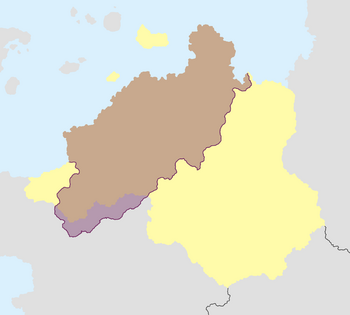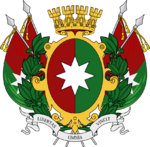Cutinsua
This article is incomplete because it is pending further input from participants, or it is a work-in-progress by one author. Please comment on this article's talk page to share your input, comments and questions. Note: To contribute to this article, you may need to seek help from the author(s) of this page. |
League of Five Cities Hunyu Pichqantin Llaqtakuna | |||||||||||||||||||
|---|---|---|---|---|---|---|---|---|---|---|---|---|---|---|---|---|---|---|---|
| 1324–1530 | |||||||||||||||||||
|
Attested banners of the League of Five Cities | |||||||||||||||||||
 Cutinsua at its greatest extent, c. 1520, overlaid over modern Aucuria | |||||||||||||||||||
| Capital | Andavaila (1324-1528, de facto) Čačapojas (1528-1530, de facto) | ||||||||||||||||||
| Official languages | Runanca | ||||||||||||||||||
| Common languages | Kirua, others | ||||||||||||||||||
| Religion | Cutinsuan religion | ||||||||||||||||||
| Demonym(s) | Cutinsuan | ||||||||||||||||||
| Government | Hegemonic confederation of allied city-states | ||||||||||||||||||
| Hanan Qhapaq | |||||||||||||||||||
• 1324 - 1356 | Mankojupankis Pačakutekas | ||||||||||||||||||
• 1360 - 1393 | Atokjupankis | ||||||||||||||||||
• 1417 - 1438 | Ljokėjamaras | ||||||||||||||||||
• 1438 - 1480 | Čapatipomas Sinčijačekas | ||||||||||||||||||
• 1515 - 1528 | Javarjupankis | ||||||||||||||||||
• 1528 - 1530 | Kapakrokas | ||||||||||||||||||
| History | |||||||||||||||||||
• Formation of the League | 1324 | ||||||||||||||||||
• Conquest of Oruras | 1336 | ||||||||||||||||||
| 1530 | |||||||||||||||||||
| |||||||||||||||||||
| Today part of | |||||||||||||||||||
The League of Five Cities (Classical Runanca: Hunyu Pichqantin Llaqtakuna), more commonly known as Cutinsua (Classical Runanca: Sunquntinsuyu; Kirua: Lluquayllu), was an alliance of five Runanca city-states - Andavaila, Čačapojas, Suljanas, Lambajekė, and Akarajas - that ruled much of northern Aucuria from 1324 until its conquest by the Ruttish užkariautojas Jurgis Leikauskas in 1530.
The League of Five Cities was formed in response to the military expansion of the Kingdom of Oruras, which was perceived as an existential threat by its founding members. The League subsequently defeated and conquered Oruras in a series of wars, and expanded from its heartland in the Vaskaranas Mountains to control much of northern Aucuria through a mixture of diplomacy, assimilation, intimidation, and conquest. Though nominally an equal alliance between all five of the League's founding members, Andavaila quickly became the dominant member politically, economically, and militarily, steadily forcing the others into subsidiary roles.
At its peak, Cutinsua controlled almost all of northern Aucuria and some regions of northeastern Nuvania. Cutinsuan rule was hegemonic and often indirect, with local elites permitted to retain their titles if they paid tribute to the League and the leaders of polities that resisted replaced by semi-autonomous stewards appointed by Andavaila. Cutinsua developed a complex system of roads, inns, and warehouses to facilitate administration and trade, constructed monumental works of architecture, used knotted strings called kipu for record-keeping, and oversaw a flourishing of textile-making, metalworking, and agriculture. Notably, the empire functioned internally largely without money, with the exchange of goods & services handled through reciprocity and taxes paid through the mit'a and minka systems of corvée labor. Cutinsuan religion was highly polytheistic, centered around a litany of deities and sacred objects.
In 1528, Cutinsuan envoys met with Jurgis Leikauskas and invited him to Andavaila. While there, Leikauskas met with envoys from Čačapojas, Suljanas, and Akarajas who relayed to him their resentment of Andavailan dominance within the League. Leikauskas agreed to aid them in a rebellion against Andavaila, which saw forces from Andavaila and Lambajekė repeatedly defeated and Andavaila itself viciously sacked in October of the same year. Čačapojas, Suljanas, and Akarajas subsequently seized a leading role in a rump League of Five Cities; however, their relations with Leikauskas and his forces quickly broke down, and, by 1530, Ruttish užkariautojai had destroyed their former allies, completing the Ruttish conquest of Cutinsua.
While efforts were made to revive the League by several indigenous revolts, most famously the 1608-1612 Great Cutinsuan Revolt, none of these efforts were successful. Nonetheless, Cutinsuan and neo-Cutinsuan resistance to Ruttish and, later, Rudolphine colonialism became important symbolically to indigenous rights movements among the Runanca and Kirua in contemporary Aucuria.
Etymology
The official name of the polity commonly referred to as Cutinsua was the League of Five Cities (Classical Runanca: Hunju Pičqantin Laqtakuna), in reference to the five city-states - Andavaila, Čačapojas, Suljanas, Lambajekė, and Akarajas - which were its founding members. These five founding members were nominally co-equal within the polity, with later members being accorded a subordinate status; in practice, the alliance was dominated by Andavaila, which was the location of the League's official meeting site and its treasury.
Cutinsuans sometimes euphemistically referred to their polity as "the middle territories" (Runanca: Sunquntinsuyu; Kirua: Lluquayllu), as they believed it to be situated upon the middle of the world. When Ruttish explorers and colonists arrived in the region, they rendered the Runanca Sunquntinsuyu into Ruttish as Kutinsuja, which subsequently became the source of the English "Cutinsua".
History
Antecedents
[previous civilizations in the vaskaranas; pativilkas, kiljakoljas, tirakvas, piura, kulkincas]
Formation
The Runanca people are known to have been present in north-central Aucuria, practicing a semi-sedentary form of pastoralism, by the 12th century. Their exact relationship with the previous civilizations in the Vaskaranas is unclear; while they are widely agreed to be unrelated to the Kulkinčas culture (who spoke Močikas, a language isolate), debate exists about whether the Runanca might be related to the earlier Piura culture. Elena Kvedarauskienė and Samuel Lorenz, noting the location of the likely urheimat of the Runanca language in what is now Pakrashchia and Oroncota, theorized that the Piura & Runanca are the same people and that the expansion of the Kirua peoples in what is now Kunturiri forced them westward into Pakrashchia and Oroncota. However, other scholars - such as Augustinas Vingrys, Oljantas Lozoravičius, and Léandre Perrault de Vézelay - have argued that the Piura more likely spoke the now-extinct Pukvina or Leko languages, or noted that there is little tangible evidence to confirm a link between the Piura and Runanca.
By the 13th century, the Runanca were the primary population group in the region and had become overwhelmingly sedentary, settling in a network of city-states which were primarily located along major rivers in the Vaskaranas Range and its foothills. These city-states were generally headed by hereditary monarchs styled with the title qhapaq (literally "mighty one"), and some had been settled locations well before the Runanca shifted fully to sedentism. Among the city-states were Andavaila and Suljanas on the Čančamaja River, Lambajekė on its tributary the Nupė, Čačapojas on the Lukumaja, and Akarajas on the Žavaris; these five in particular quickly became some of the most prominent city-states, as their locations were ideal for agriculture, mining, trade, or some combination thereof. Concurrently, the southeastern regions of the Vaskaranas range, dominated by the Kirua people, were being unified by the Kingdom of Oruras. Known to have existed historically since 1252, Oruras rapidly established control over the basin of the Apurimakas throughout the 13th century and, by the end of the century, had extended its reach as far south as the upper reaches of the Japakanis River.

With control of its southern frontier secured, Oruras increasingly looked to extend its control over the Runanca city-states to its north, whose agricultural and mineral production would be a sizeable asset for any monarch who could establish their rule over them. Beginning in the 1310s, the Oruran king Čukivankas began to lead organized raids against nearby Runanca city-states, demanding that their leaders become his vassals and offer tribute to Oruras.
As Oruran expansionism became a matter of increasing concern for the Runanca city-states, the qhapaq of Andavaila, Mankojupankis, began to call for the creation of an defensive alliance between the leading city-states to resist Oruran aggrandizement. These efforts were largely focused on winning the support of other prominent city-states, as they would be able to bring smaller towns which had placed themselves under their protection to the alliance in the process. After Oruran armies attacked the town of Laurikočas - the farthest north they had struck - in 1323, the qhapaqs of Čačapojas, Suljanas, Lambajekė, and Akarajas agreed to Mankojupankis's proposal, and the League of Five Cities was formally established early in 1324.
Early expansion and consolidation
[mankojupankis and the repulsion & conquest of oruras, tupakvalpas, atokjupankis v javarvakakas and the consolidation of andavailan hegemony, sinciankas, tupakukumarkis]
Later expansion and reform
[the wars of ljokeamaras, the conquests and reforms of capatipomas, maitakapakis, ljaktakusaris, and the early years of javarjupankis]
Ruttish conquest
[the arrival of jurgis leikauskas, early encounters leading to the cutinsuan civil war, sack of andavaila, & death of javarjupankis, tupakarancas's efforts to continue resistance, the betrayal of kapakrokas and the death of the league]
The last Cutinsuans
Government
[general structure of league membership - the five original cities, voluntary member cities & tributaries, conquered polities]
[administration within the five original cities]
[structures for administering the league; also legal/judicial structures]
[administration of voluntary member cities & tributaries]
[administration of conquered polities]
Society
Religion
Economy
[domestic economy]
[artifacts prove trade relations with Térachu, the Mwiska, and the Nati & Mutu peoples of the Arucian, but also with Tzapotla, Calkhun, and Itzel ]


